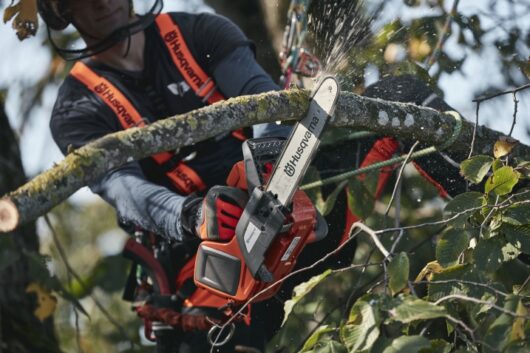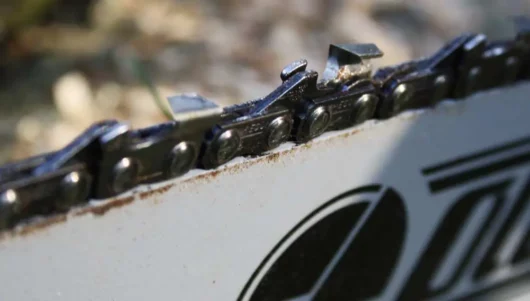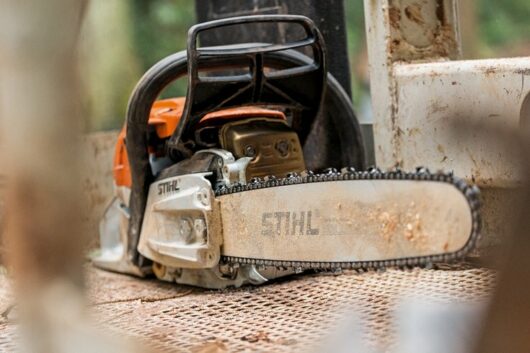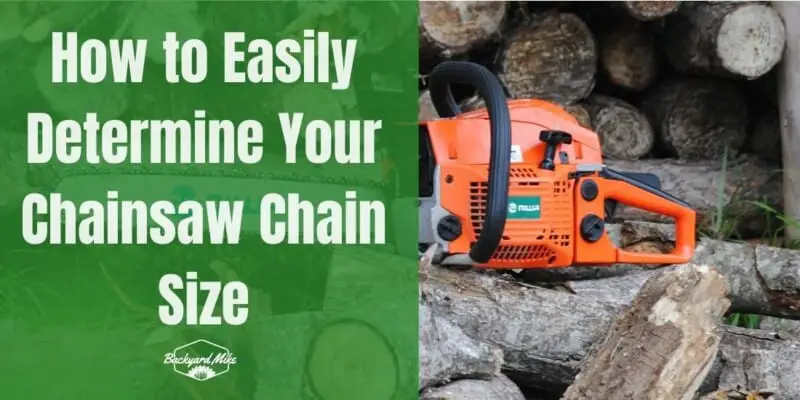Are you struggling to determine what size chainsaw chain you need for your saw? It can be confusing to figure out, but don’t worry! In this article, we’ll provide a simple step-by-step guide to help you easily determine your chainsaw chain size. With the information in this article, you’ll know what size chain you need in no time. So, let’s get started!
What is a chainsaw chain?
A chainsaw is a handy tool for people involved in the forestry industry or for homeowners looking to trim trees and cut wood. One of the most important components of a chainsaw is the chain.
A chainsaw chain is a metal chain that wraps around the guide bar of the chainsaw. It consists of a series of teeth or also known as cutters are responsible for carrying out the cutting. The chain gets powered by the chainsaw’s engine, which ends up driving sprocket that rotates the chain around the guide bar.
There are three primary types of chainsaw chains – full chisel, semi-chisel, and low-profile. Each type of chain has its unique design and is suited for carrying out different types of cutting tasks.

#1. Full chisel chains
Full chisel chains come with sharp, square-shaped teeth and are designed for cutting through the hard, dense wood. These chains are perfect for professional use. Moreover, they are also used by loggers and arborists. Full chisel chains happen to be the most aggressive type of chainsaw chain, which makes them the fastest cutting chains available. However, they’ll require more frequent sharpening and are much more prone to dulling quickly if they accidentally come in contact with dirt, rocks, or any hard object.
#2. Semi-chisel chains
Semi-chisel chains come with rounded teeth with a slight curve on the cutting teeth. These chains are much more durable compared to full chisel chains and can withstand hitting rocks, dirt, and other objects without dulling quickly. Semi-chisel chains are perfect for homeowners who have to carry out occasional cutting like trimming trees and splitting firewood.
#3. Low-profile chains
Low-profile chains are designed for smaller and lighter chainsaws, and they come with small, rounded teeth. These chains are perfect for pruning and light-duty cutting tasks, although they might not be the best option for heavy-duty cutting or professional use.
In addition to the three types of chainsaw chains, there are also specialized chainsaw chains available for carrying out specific cutting tasks. For example, skip-tooth chains come with fewer teeth and are designed to cut through thicker, tougher wood. Meanwhile, ripping chainsaws are specifically designed for cutting with the grain of wood and are perfect for creating lumber.
How to determine chainsaw chain size?
When it comes to choosing the right chainsaw chain for your cutting needs, it’ll be important to know the measurements and size of your chainsaw first. This is why you will want to know how to determine chainsaw chain size. There are three main measurements that you’ll need to know – pitch, gauge, and number of links.
Measuring the pitch of the chain
The pitch of a chainsaw chain is used to refer to the distance between the drive links, the teeth that fit into the guide bar of the chainsaw. For measuring the pitch of the chain, you will have to measure the distance between three consecutive rivets and divide it by two. The most common pitch sizes are 0.325 inches, 3/8 inches, and ¼ inches. Each size is suitable for different types of cutting tasks. For example, smaller pitch sizes will be suitable for smaller chainsaws and lighter-duty tasks, whereas large pitch sizes are appropriate for larger chainsaws and heavy-duty tasks.
Measuring the gauge of the chain
The gauge of a chainsaw chain refers to the thickness of the drive links. For measuring the gauge of the chain, you will have to measure the thickness of the drive link and round up to the nearest thousandth of an inch. The most common gauge sizes are 0.050 inches, 0.058 inches, and 0.063 inches. Each size is suited for different types of cutting jobs. Smaller gauge sizes are more suited for smaller chainsaws and carrying out lighter-duty tasks. Meanwhile, larger gauge sizes are better suited for larger chainsaws and heavy-duty tasks.
Measuring the number of links
The number of links in a chainsaw chain is an important measurement to consider when choosing the right chain for your needs. For determining the number of links in a chain, you will have to count the number of drive links in the chain. This measurement will be important as it’ll determine the length of the chain and whether it can fit your chainsaw’s guide bar. It is important to select a chain with the correct number of links to make sure you get proper operation and safety.
How to measure chainsaw chain size
When using a chainsaw, selecting the right chainsaw size will be essential for ensuring safe and efficient operation. One of the most important factors to consider when choosing the correct chainsaw chain would be to determine the correct size, which can be determined by three measurements – pitch, gauge, and the number of drive links.

Measuring pitch
The pitch of the chainsaw chain refers to the distance between any three consecutive rivets of the chain. For measuring the pitch, you will have to use a ruler or tape measure. First, you will need to measure the distance between three consecutive rivets on the chain. Next up, you will need to divide the measurement by two. The result is the pitch of the chainsaw chain.
Some of the common pitch sizes include 1/4 inches, 3/8 inches, and 0.325 inches, with each size being suited for different types of cutting tasks. Smaller pitch sizes are more appropriate for smaller chainsaws to carry out lighter-duty tasks. A larger pitch size will be more appropriate for larger chainsaws to carry out heavier-duty tasks.
Measuring gauge
The gauge of a chainsaw chain will refer to the thickness of the drive links on the chainsaw chain. For measuring the gauge, you will require a caliper. First, you should locate the drive links on the chain. These are the links that will fit into the chainsaw’s guide bar. Next up, you should measure the thickness of the drive links with the help of the caliper. You must round up this measurement to the nearest thousandth of an inch for determining the gauge of the chainsaw chain.
The common gauge sizes are 0.050 inches, 0.058 inches, and 0.063 inches. Like pitch sizes, gauge sizes are also suited for different types of cutting tasks. Smaller gauge sizes are suited for light-duty tasks, whereas larger gauge sizes are perfect for heavy-duty tasks.
Measure the number of drive links
The number of drive links on a chainsaw chain will help determine its length and whether it is suitable for a particular chainsaw model. For measuring the number of drive links, you must count the number of drive links on the chain. This measurement will be important, as using a chainsaw chain with an incorrect number of drive links could damage the chainsaw and pose a safety hazard.
For making sure you have the correct number of drive links, you must consult the owner manual of the chainsaw or contact the manufacturer. You can even use an online chain finder tool, and it’ll help you find the correct chain for the chainsaw.
How to tell the chainsaw chain size
Selecting the right chainsaw chain size will be crucial for the proper functioning of the chainsaw. Understanding the measurements and determining the pitch of the chain, the gauge of the chain, and the number of links will be key to choosing the accurate chainsaw chain size.
Understand the measurements
Before you tell the chainsaw chain size, it’ll be essential that you understand the exact measurements. The pitch of the chainsaw chain will refer to the distance between the drive links on your chain. Meanwhile, the gauge of the chain will refer to the thickness of the drive links on your chainsaw chain. The drive links will refer to the number of drive links on your chain.
Determine the pitch of the chain
For determining the pitch of the chainsaw chain, you must measure the distance between three consecutive rivets on the chainsaw chain. Divide the distance by two, and this will give you the pitch of the chain. The most common pitch sizes include 0.325 inches, 3/8 inches, and ¼ inches. Each size serves chainsaws to carry out different types of cutting tasks.
Determining the gauge of the chain
You can determine the gauge of your chainsaw by measuring the thickness of the drive links with the help of the caliper. Round up the measurement to the nearest thousandth of an inch for determining the final gauge of the chain. Common gauge sizes include 0.050 inches, 0.058 inches, and 0.063 inches. Using the wrong gauge size could cause the chainsaw chain to stretch, which could end up damaging the chainsaw and reduce cutting performance.
Determine the number of links
For determining the number of drive links in the chainsaw chain, you will have to count the number of drive links on the chain. The number of links will be crucial, as using the chain with an incorrect number of links could pose a safety threat and end up damaging the chainsaw. You must refer to the chainsaw manual or contact the manufacturer for guidance on the correct number of links.
When selecting the right number of links, it’ll be essential to consider the pitch and gauge of the chain alongside the size of the chainsaw. Moreover, double-check the measurements and confirm that the chain is the correct measurement before operating the chainsaw.

How to know chainsaw chain size
Knowing the appropriate size of chainsaw chain will be important for safe and efficient chainsaw operation. When determining the size of the chainsaw chain, it’ll be important to check the manufacturer’s specifications and the pitch, gauge, and number of links on the chain.
Check the manufacturer’s specifications
The first step to determine the size of the chainsaw chain will be to check the manufacturer’s specifications. Every chainsaw model will require a specific size of chain, and the manufacturer will provide the information in the owner’s manual or on their website.
Check the manual or website to find out the recommended chain pitch, gauge, and the number of links for the chainsaw model. Using a chainsaw chain that isn’t recommended by the manufacturer may result in poor cutting performance, damage to the chainsaw, or even safety hazards.
Check the pitch
The pitch of the chainsaw chain is the distance between the center of two drive links. For checking the pitch of the chain, you must measure the distance between three consecutive rivets before dividing it by two. The common pitch sizes for chainsaw chains are ¼ inches, 3/8 inches, and 0.325 inches. If the measurement matches one of these three sizes, you’ve got the correct pitch for the chainsaw chain.
Check the gauge
The gauge of a chainsaw chain will refer to the thickness of the drive links. For checking the gauge of the chain, you will have to measure the width of the groove on the bar where the chain is sitting.
The common gauge sizes for chainsaw chains will include 0.050 inches, 0.058 inches, and 0.063 inches. If the measurement matches one of these sizes, then it means you have the correct gauge for the chainsaw chain.
Check the number of links
The number of links on a chainsaw chain will determine the length of the chain. For checking the number of links on the chain, you will have to count the number of drive links on the chain. You should ensure that you’re matching the number of links with the manufacturer’s recommended chain length for your particular chainsaw model. Using a chain that is too long or too short can end up causing the chain to slip, damage the chainsaw, or pose a safety hazard.
How to count chainsaw links
Chainsaw chains come in different sizes and lengths. This is why it is important to know how to count the links on the chain accurately. Counting chainsaw links is important when you have to replace the chain or resize it to fit the chainsaw. Normally, you have to count the chainsaw links but in some cases, you might have to estimate the number of links on the chainsaw chain. Here is how you can count chainsaw links and how to estimate chainsaw links.
How to count chainsaw links
Counting the links on a chainsaw chain will be a straightforward process that can be carried out with a little patience and attention to detail. Here is how you can count chainsaw links accurately –
- Start off by placing the chain on a flat surface, with the cutting teeth facing up
- Identify the first link of the chain, which is the drive link and the part of the chain that sits in the guide bar
- Count every link on the chain by moving the finger along the chain and say one for each link you pass
- Once you have counted the links on the chain, you will have the total number of links
It is important to note that some chainsaw chains will have different types of links, such as safety links or skip links. These links don’t have cutting teeth, and you shouldn’t include them when counting the total number of links on the chain.
How to estimate chainsaw links
In some cases, you might have to estimate the number of links on the chainsaw chain. This can be performed by measuring the length of the chain and using a simple calculation for estimating the number of links. Here is how you can estimate the number of chainsaw links –
- Measure the length of the chainsaw chain by stretching it out along a flat surface
- Use a tape measure or tape for measuring the length of the chain in inches
- Multiply the length of the chain by 2.54 (number of centimeters in an inch) for converting the length to centimeters
- Divide the length in cm by the pitch of the chain
- Round off the result of the calculation to the nearest whole number for estimating the number of links on the chain
It is important to note that estimating the number of links on your chain isn’t as accurate as counting the links directly. However, it can be a useful tool if you do not have access to the chain or need to make a quick estimate.
Problems that arise if you use the wrong chainsaw chain measurements
A chainsaw is a powerful tool that can be used for carrying out a wide range of applications, from felling trees to cutting firewood and more. However, it is important that you always use the right chain size for your particular chainsaw model. Using the wrong size chain will have a number of negative consequences that can be quite dangerous and damaging to not just the chainsaw, but to the user as well.
#1. Decreased cutting performance
Firstly, using the wrong chainsaw chain size could result in decreased cutting performance. Chainsaws are designed for working with specific chain sizes, and using a chain that is too small or too large could result in inefficient cutting, slower work, and reduced precision. If a chain is too small, it might not be able to make clean cuts through the wood. Meanwhile, if a chain is too large, it can cause the chainsaw to vibrate excessively, which makes it difficult to control and increases the risk of accidents.
#2. Increased wear and tear
Aside from the reduced cutting performance, using the wrong chainsaw chain size can result in increased wear and tear on the chainsaw. A chain that is too small might not fit properly on the bar, which can cause it to slip and wear down the bar’s groove. It can result in a loss of tension on the chain, which means it could come off during use. On the other hand, a chain that is too large could result in excess strain on the chainsaw’s motor, causing it to wear down faster or even break down altogether.
#3. Risk of accidents and injuries
Using the wrong size of chainsaw chain can increase the risk of accidents and injuries. If a chain is too small, it might not be able to handle the stress of cutting, causing the chain to snap or break during use. It can send sharp pieces of metal flying through the air and pose a serious risk to the user. Similarly, if a chain is too large, it can be quite difficult to control. This increases the risk of the chainsaw kicking back and causing serious injuries to the user.
#4. Reduction in the lifespan of the chainsaw
Lastly, using the wrong chainsaw chain size can also result in a reduction in the lifespan of your chainsaw. The added stress and strain on your chainsaw can cause it to wear out faster. Ultimately, it’ll require more frequent maintenance and repairs. Over time, this can add up to a significant expense, both in terms of time and money.
FAQs
What is the best way to measure the size of my chainsaw chain?
The best way to measure the size of a chainsaw chain is to count the number of drive links, which are the links that connect the blades to the chainsaw bar. The drive link count will tell you the size of the chainsaw chain and can be found either in the owner’s manual or stamped onto the drive link itself.
What other factors should I consider when determining the size of my chainsaw chain?
In addition to the number of drive links, you should also consider the pitch and gauge of the chainsaw chain. Pitch is the distance between three consecutive rivets divided by two, and gauge is the width of the drive link. Both pitch and gauge should be the same as the specifications listed in the owner’s manual or on the chainsaw chain itself.
How do I know if my chainsaw chain is the right size?
If your chainsaw chain has the same pitch, gauge, and number of drive links as specified in the manual or on the chain itself, then it is the appropriate size. If it does not match the specifications, then you should replace the chain with one that does.


